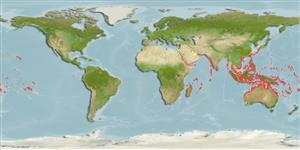>
Eupercaria/misc (Various families in series Eupercaria) >
Labridae (Wrasses)
Etymology: Labroides: Greek, labrax, -akos = a fish, Dicentrarchus labrax + Greek, suffix, oides = similar to (Ref. 45335).
More on author: Valenciennes.
Environment: milieu / climate zone / пределы глубины / distribution range
экология
морской ассоциированный с рифами; немигрирующий; пределы глубины 0 - 100 m (Ref. 128797), usually 1 - 30 m (Ref. 27115). Tropical; 24°C - 28°C (Ref. 27115); 32°N - 36°S, 24°E - 124°W
Indo-Pacific: Persian Gulf (Ref.80050); Red Sea and East Africa (Ref. 4392) to the Line, Marquesas, and Ducie islands, north to southern Japan, south to Lord Howe and Rapa islands.
Size / Вес / Возраст
половая зрелость: Lm ? range ? - ? cm
Max length : 14.0 cm TL самец/пол неопределен; (Ref. 55367); наибольший возраст (опубликованны данные): 4 годы (Ref. 3426)
Краткое описание
определительные ключи | морфология | морфометрия
колючие лучи спинного плавника (общее число) : 9; членистые (мягкие) лучи спинного плавника (общее число) : 10 - 11; колючие лучи анального плавника: 3; членистые (мягкие) лучи анального плавника: 10. Often with yellow back in deep water (Ref. 48636). Scales on lateral line: 50-52 (+2 past hypural) (Ref. 1602).
Body shape (shape guide): elongated; Cross section: compressed.
Inhabits coral rich areas of inner lagoons and subtidal reef flats to seaward reefs (Ref. 1602). Feeds on crustacean ectoparasites and mucus of other fishes (Ref. 9823, 48636). Monogamous (Ref. 52884). A protogynous hermaphrodite (Ref. 55367). Stays in stations where other fish come to be cleaned. Cleaning intensity is not related to client size or commonness (Ref. 28019). Cleaning stations are occupied by a pair of adults, a group of juveniles or a group of females accompanied by a dominant male where a female becomes a functional male if the dominant male disappears (Ref. 5503). Some adults solitary and territorial. An unfamiliar visitor is usually greeted by dance-like movements with the tail maneuvering the back part of the body up and down. Juveniles behave this way when divers approach closely (Ref. 48636). Minimum depth range of 1 meter in Ref. 27115.
Life cycle and mating behavior
половая зрелость | размножение | нерест | икра | Fecundity | личинки
Bi-directional sex change has been confirmed for this species (Ref. 103751). Oviparous, distinct pairing during breeding (Ref. 205). Pelagic spawners. Sex reversal is completed in 14-18 days (Ref. 34185, 34258). A monandric species (Ref. 55367). Length at sex change = 8.8 cm TL (Ref. 55367). Monogamous mating is observed as both facultative and social (Ref. 52884).
Randall, J.E., G.R. Allen and R.C. Steene, 1990. Fishes of the Great Barrier Reef and Coral Sea. University of Hawaii Press, Honolulu, Hawaii. 506 p. (Ref. 2334)
Статус Красного Списка МСОП (Ref. 130435: Version 2025-1)
Угроза для людей
Harmless
Использование человеком
рыболовство: интереса не представляет; аквариум: коммерческий
дополнительная информация
инструменты
Специальные отчеты
Скачать в формате XML
ресурсы в Интернет
Estimates based on models
Preferred temperature (ссылка
123201): 24.6 - 29, mean 27.8 °C (based on 1388 cells).
Phylogenetic diversity index (ссылка
82804): PD
50 = 0.5312 [Uniqueness, from 0.5 = low to 2.0 = high].
Bayesian length-weight: a=0.00589 (0.00335 - 0.01035), b=3.17 (3.01 - 3.33), in cm total length, based on LWR estimates for this species & (Sub)family-body (Ref.
93245).
Trophic level (ссылка
69278): 3.5 ±0.4 se; based on diet studies.
устойчивость к внешним воздействиям (ссылка
120179): средний (среднего размера), минимальное время удвоения популяции 1.4-4.4 года (tmax=4).
Fishing Vulnerability (Ref.
59153): Low vulnerability (10 of 100).
🛈
Nutrients (Ref.
124155): Calcium = 103 [54, 177] mg/100g; Iron = 0.69 [0.39, 1.37] mg/100g; Protein = 18 [15, 20] %; Omega3 = 0.104 [0.059, 0.182] g/100g; Selenium = 27.8 [13.9, 56.3] μg/100g; VitaminA = 140 [40, 597] μg/100g; Zinc = 1.76 [1.15, 2.82] mg/100g (wet weight);
